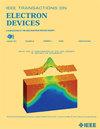Improved Stability of Fully Recessed Normally-Off GaN MIS-HEMTs With SiNx/AlN Dielectric Stack
IF 3.2
2区 工程技术
Q2 ENGINEERING, ELECTRICAL & ELECTRONIC
引用次数: 0
Abstract
This work presents a comparative study of GaN metal-insulator-semiconductor high-electron-mobility-transistors (MIS-HEMTs) employing LPCVD-SiNx/ALD-AlN or PEALD-SiO2/ALD-AlN dielectric stacks. The SiNx/AlN MIS-HEMTs exhibit a minimal threshold voltage shift (具有SiNx/AlN介电层的全凹槽正常关断GaN mishemt的稳定性提高
本文介绍了采用LPCVD-SiNx/ALD-AlN或PEALD-SiO2/ALD-AlN介电堆的GaN金属-绝缘体-半导体高电子迁移率晶体管(mis - hemt)的比较研究。在$150~ $ {\circ}$ C下,SiNx/AlN miss - hemts具有最小阈值电压移($\Delta {V}_{\text {TH}}$)为- 0.24 V,通断电流比高达$10^{{8}}$,而SiO2/AlN miss - hemts的阈值电压移为$\Delta {V}_{\text {TH}}}=2.0$ V。在栅极偏置应力下,SiNx/AlN器件显示$\Delta {V}_{\text {TH}}$为−0.90 V(正)和−0.45 V(负),而SiO2/AlN器件为−1.75 V和3.31 V。在维持$10^{{4}}$ s的失态漏极偏置应力后,SiNx/AlN miss - hemt获得了−0.45 V的小$\Delta {V}_{\text {TH}}$。稳定性的提高是由于低压化学气相沉积(LPCVD)工艺和富氮环境使SiNx/AlN堆栈的界面质量更好。这些发现强调了LPCVD-SiNx/ALD-AlN介电层在推进GaN miss - hemt的高性能和可靠的功率开关应用方面的潜力。
本文章由计算机程序翻译,如有差异,请以英文原文为准。
求助全文
约1分钟内获得全文
求助全文
来源期刊

IEEE Transactions on Electron Devices
工程技术-工程:电子与电气
CiteScore
5.80
自引率
16.10%
发文量
937
审稿时长
3.8 months
期刊介绍:
IEEE Transactions on Electron Devices publishes original and significant contributions relating to the theory, modeling, design, performance and reliability of electron and ion integrated circuit devices and interconnects, involving insulators, metals, organic materials, micro-plasmas, semiconductors, quantum-effect structures, vacuum devices, and emerging materials with applications in bioelectronics, biomedical electronics, computation, communications, displays, microelectromechanics, imaging, micro-actuators, nanoelectronics, optoelectronics, photovoltaics, power ICs and micro-sensors. Tutorial and review papers on these subjects are also published and occasional special issues appear to present a collection of papers which treat particular areas in more depth and breadth.
 求助内容:
求助内容: 应助结果提醒方式:
应助结果提醒方式:


